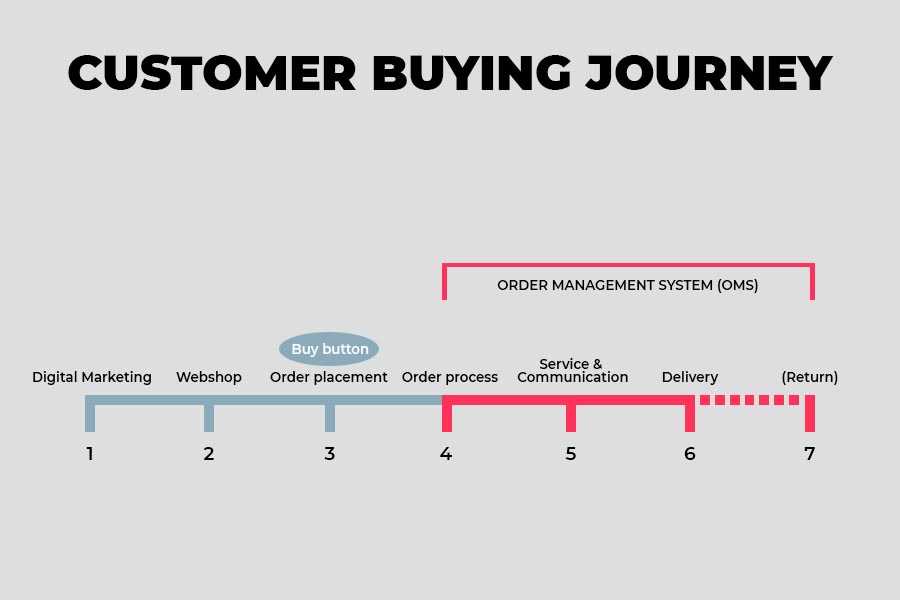You might know the following scenario… You have ordered a T-shirt online.
The webshop tells you that there is a two-day delivery time, but after two days you have not even received an order confirmation. You contact customer service, which takes a couple of days to reach, because you don’t have an order number to pass on (because you don’t have an order confirmation). They respond that the package should have been sent, but you haven’t received any kind of confirmation about shipping, nor delivery…
This is, without great surprise, an example of bad customer service that doesn’t create loyalty, by any means. But how do you make sure that your digital business lives up to the customers’ expectations, so they avoid a similar experience?

We experience that digital merchants have become great at the first part of the customer buying journey. Many, though, should focus on a higher quality in the process after the buy button. This is where improvement can be done.
A NEW VIEW ON THE BUYING PROCESS
The customers make extremely high demands on online shopping today. And they are unsettled in their choice of sales channel. Today, it’s not longer enough that the design is nice, and the user-friendliness is first class. It’s, on the other hand, also the process after the buy button that determines if you customers get a great experience and therefore become loyal. Customer service, including order management, is crucial for the overall customer experience.
Where most brands seem to keep track in regard to the buying process before the purchase, there is a need for a different view and another approach to the part of the buying process that follows after the purchase, as shown in the graphic above. It simply needs to be higher prioritized if you want to gain more loyalty from your customers.
It also means that the relation between customer and customer service has to be transparent when it comes to order management.
The digital business must focus more on the last part of the customer buying journey in order to fulfill the customers’ expectations about today’s e-commerce, as it has a vital effect on the customer’s experience of your brand and their willingness to do business with you again.
WHAT DO CUSTOMERS REALLY EXPECT?
Today, customers expect the following when dealing with your brand:
- Less friction in touchpoints – in-store, online, social media etc. They even expect them to be all connected.
- Full flexibility and recognizability on all sites where the brand is present. Flexibility is about “selling anywhere, anytime”. The full inventory must be available in all channels at all times.
- The last part of the ordering process has to be transparent. This part of the customer buying journey has great impact on whether the customer will return.
STOCK, SHIPPING, DELIVERY AND RETURN
An order management solution takes care of the part of the customer buying journey that begins after the customer has clicked on the buy button. We also call it OMS (order management system). OMS is not a simple affair, but is overall about stock, shipping, delivery and return. If you have stores, these should be integrated with the webshop. The customers expect that you offer the full and exact product range in all channels. And they want lightning fast and flexible shipping and delivery. Moreover, there must be a clear insight into where the order is located. And it should of course be easy and unproblematic to return the product, if it wasn’t as desired.
DIFFERENT SOLUTIONS
Just as CRM (customer relationship management) is the 'system of record' for customer data, so is OMS the 'system of record' for orders and inventory.
An OMS orchestrates the supply side of the customer experience and helps customer service by giving full insight to where the order is located, so it can be communicated to the customer, while ensuring that all products in all stores are available. The communication between customer and customer service has to a flawless and transparent experience, and it must be made sure that all products are available for sale in all channels.
SEE ALSO: Guide: When do you need OMS?
There are of course different ways to solve the order management problem. There are companies that build order management systems, like there are brands that succeed by creating their own solutions. Because it’s not an easy solution. It can make sense, though, to join forces with someone who specializes in order management, such as Salesforce. But it also requires you to know your starting point. Is it B2B, B2C or maybe both? Either way, you should analyze your needs and consider whether OMS is relevant now or only at a later date for your specific business.
WHY AN ORDER MANAGEMENT SOLUTION?
OMS is about the experience after the buy button. With OMS you transform the customer experience and create loyal customers..
To be more exact, it means that…
- OMS provides a better customer service, because the ordering process and customer service are optimized with a 360-degree picture.
- It’s an advanced tool to configure your fulfillment business rules and order allocation. It’s also a dynamic system you form without the need of development, as the business grows larger.
- OMS provides an opportunity to automate fulfillment, accounting and ordering processes.
QUESTIONS YOU SHOULD CONSIDER…
- How much do you save, by making logistics and customer service work faster and more efficiently?
- What does it cost you when your customers go in vain and they are discouraged from buying a product that you have, but cannot offer?
- Who knows how many sales channels you have to support in three years? No one can predict the channels that will be used in a decade. With OMS, you make yourself more flexible so you can follow the evolution.




